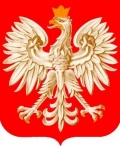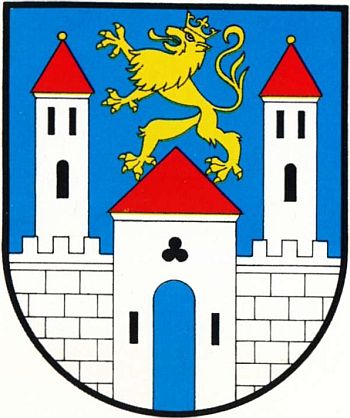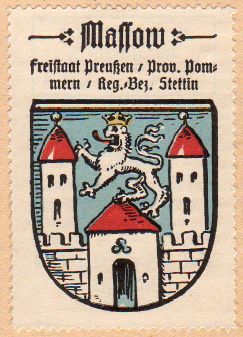Maszewo (Goleniów): Difference between revisions
Knorrepoes (talk | contribs) m (Text replacement - "===Official blazon=== ===Origin/meaning===" to "{| class="wikitable" |+Official blazon |- |'''Polish''' | {{blazon wanted}} |- |'''English''' | {{blazon wanted}} |} ===Origin/meaning=== ") |
Knorrepoes (talk | contribs) m (Text replacement - "===Origin/meaning=== The" to "===Origin/meaning=== The") |
||
| Line 19: | Line 19: | ||
===Origin/meaning=== | ===Origin/meaning=== | ||
The arms are a combination of a city gate and the lion of the Counts of Eberstein. The latter ruled the city in the 15<sup>th</sup> century. The arms first appear on a seal from the early 17<sup>th</sup> century, and have not changed until 1945.<br/> | The arms are a combination of a city gate and the lion of the Counts of Eberstein. The latter ruled the city in the 15<sup>th</sup> century. The arms first appear on a seal from the early 17<sup>th</sup> century, and have not changed until 1945.<br/> | ||
Before 1600 the city used completely different compositions on its seals. The oldest seals, from the early 15<sup>th</sup> century, show a torso of a man, most likely a bishop of Kammin, as the city belonged to the diocese of Kammin and the bishops had granted the city rights. Around 1600 a seal was made, showing a pentagram as the only symbol, its meaning unknown | Before 1600 the city used completely different compositions on its seals. The oldest seals, from the early 15<sup>th</sup> century, show a torso of a man, most likely a bishop of Kammin, as the city belonged to the diocese of Kammin and the bishops had granted the city rights. Around 1600 a seal was made, showing a pentagram as the only symbol, its meaning unknown | ||
Revision as of 08:56, 18 July 2022
Poland heraldry portal
This page is part of the Poland heraldry portal |
Heraldry of the World |
|
Civic heraldry:
|
Other heraldry: |
MASZEWO
Province: Pomorze Zachodnie
County: Goleniów
Origin/meaning
The arms are a combination of a city gate and the lion of the Counts of Eberstein. The latter ruled the city in the 15th century. The arms first appear on a seal from the early 17th century, and have not changed until 1945.
Before 1600 the city used completely different compositions on its seals. The oldest seals, from the early 15th century, show a torso of a man, most likely a bishop of Kammin, as the city belonged to the diocese of Kammin and the bishops had granted the city rights. Around 1600 a seal was made, showing a pentagram as the only symbol, its meaning unknown
| The seal from around 1900 |
The arms in the Kaffee Hag albums +/- 1925 |
Contact and Support
Partners:
Your logo here ?
Contact us
© since 1995, Heraldry of the World, Ralf Hartemink 
Index of the site
Literature : Plewako and Wanag, 1994














